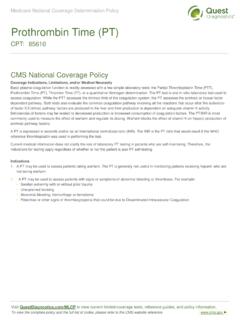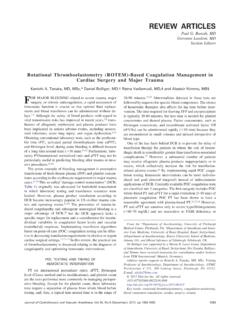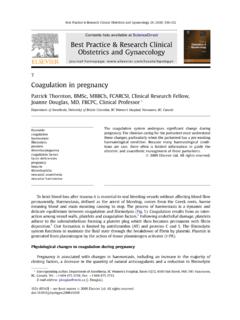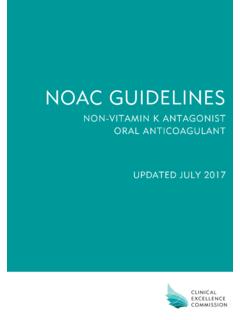Transcription of Blood Collection Tube Top Colors
1 Blood Collection Tube Top Colors Light Blue top Red top tube - Serology and Immunohematology Red top tube - Chemistry Light Green top or Green top Lavender top Pink top tube ( Blood Bank EDTA). Gray top Yellow top tube (ACD solution A) or (ACD solution B). Royal Blue top; serum, no additive or sodium heparin White top Order of the Draw To prevent contamination of tubes with additives from other tubes it is important to draw the tubes in a SPECIFIC order called "the order of the draw". For example, if the additive in the purple stopper tube contaminates the green stopper tube this would cause a falseley decreased calcium and increased potassium.
2 The sequence of Collection of evacuated tubes in a multi-draw should be in this order: 1. Sterile/ Blood cultures (yellow stopper or bottles, most institutions use bottles). 2. Light Blue coagulation tube -NOTE: If coagulation tests only are ordered AND you are using a butterfly, draw a discard tube to collect the air in the tubing into the discard tube. Failure to do so will result in a short draw which will be rejected by the lab. 3. Red - Non-Additive - has clot activator 4. Red Gel separator tube (speckled or tiger top or gold). 5. Green (heparin). 6. Green/Gray mottled Plasma Separator Tube (PST) with heparin 7. Lavender/purple and/or pink (EDTA).
3 8. Gray top (Potassium Oxalate/sodium fluoride tube). - has the following picture. Visit their website as it has some other nice pictures and explanations. The picture below is accurate EXCEPT for the royal blue tube. Since it has a red label it would follow the light blue coagulation tube. If the royal blue tube is glass the picture may be illustrating the use of a discard tube if a butterfly was used as there is a significant amount of air in the tubing which will result in a short draw in the light blue stopper tube. LIGHT BLUE. ADDITIVE: Sodium Citrate either or Citrate, theophylline, adenosine, dipyridamole (CTAD).
4 ACTION: Citrate is an anticoagulant which binds calcium in the Blood . Calcium is required for Blood clotting. Since it is bound up the Blood cannot clot resulting in a whole Blood sample, red Blood cells and PLASMA. coagulation tubes are filled with buffered tri-sodium citrate solution. Citrate concentrations of either mol/l ( %) or mol/l ( %) are available. The choice of the concentration depends upon the policies of the laboratories. The mixing ratio is 1 part citrate to 9 parts Blood . CTAD tubes contain besides the buffered citrate solution, theophylline, adenosine and dipyridamole. These tubes MUST BE COMPLETELY FILLED due to the amount of additive in the tube.
5 Short draw tubes will be rejected. DEPARTMENT: The coagulation department in the clinical laboratory performs various tests on citrate- anticoagulated Blood specimens to determine coagulation disorders and to monitor patients receiving anticoagulation therapy such as heparin, coumadin or warfarin. A clotting profile is performed on specimens, as a screening test. According to the results of the profile, further specialized tests may be performed to determine coagulation factor deficiencies, platelet abnormalities, hypercoagulability, etc. TESTS PERFORMED. Routine coagulation tests include: Prothrombin Time (PT). Partial Thromboplastin Time (PTT).
6 Thrombin Time (TT). Fibrinogen Fibrin degradation products (FDP). D-dimer Many special coagulation tests can be performed to diagnosis various bleeding disorders, these are usually sent out to reference labs: Factor activity assays (II, V, VII, VIII, IX, X, XI, XII). Factor antigen assays (VII, X). Factor inhibitor assays (II, V, VII, VIII, IX, X, XI, XII). von Willebrand factor assays (vWF Ag, Ristocetin cofactor, Multimers, RIPA). Platelet aggregation studies (collagen, ADP, epinephrine, arachidonic acid, risocetin). Lupus Inhibitor assay (DRVVT). Thrombophilia assays (protein C, protein S, antithrombin). Activated Protein C Resistance/Factor V.
7 DNA screening Fibrinolysis assays (t-PA activity and antigen, PAI-1 activity, plasminogen, antiplasmin). Site with list of some very special coagulation tests: Duke University Regional Referral Laboratory Services PURPLE. LAVENDER. ADDITIVE: EDTA K2, EDTA K3. ACTION: The interior of the tube wall is coated with either EDTA K2 or EDTA K3. The tube is also available with an 8% liquid EDTA solution. The EDTA binds calcium ions thus blocking the coagulation cascade. EDTA tubes can be used in direct sampling analysers without actually being opened. Erythrocytes, leukocytes (white Blood cells) and thrombocytes (platelets) are stable in EDTA anticoagulated Blood for up to 24 hours.
8 Preparation of Blood smears should be done within 3 hours after Blood Collection . EDTA tubes are used for testing whole Blood in the clinical laboratory. EDTA K2 tubes are used for testing whole Blood in molecular diagnostics. EDTA K2/gel tubes are used for testing plasma in molecular diagnostics and viral load detection. HIV and HCV are stable for up to 72 hours in a non-centrifuged sample at room temperature (20 25 C). However centrifugation for EDTA K2/gel tubes should be done within 6 hours after Blood Collection for best results. Mid- term storage (up to 2. weeks) in primary tubes is recommended at 20 C. For long-term storage (over 2 weeks) at 70 C or at lower temperatures please store aliquots in cryo vials.
9 DEPARTMENT: Hematology is concerned with the study of the formed elements of the Blood : red Blood cells, white Blood cells, and platelets. Diseases of the Blood forming tissues can be detected and identified through appropriate testing and examination. TESTS PERFORMED. Routine hematology tests include: Hemoglobin Hematocrit White Blood cell (WBC) count Red Blood cell (RBC) count including MCV, MCH, and MCHC which are calculations used to determine size and shape of RBCs Platelet Count Differential - the microscopic examination of Blood Complete Blood Count - the complete Blood count includes ALL of the following tests: red Blood cell count, platelet count, white Blood cell count, hemoglobin and hematocrit.
10 Reticulocyte count Eosinophil count Other special tests can be performed in the hematology department: Erythrocyte sedimentation rate AKA Sed Rate or ESR. Sickle cell test Body fluid counts - Cerebrospinal Fluid (CSF), pleural fluid, pericardial fluid, peritoneal fluid, and synovial fluids may be submitted for cell counts. Chemistry Hemoglobin A1C. RED. ADDITIVE: Glass - NONE. Plastic - clot activators to enhance the clotting of Blood , tube inversions are necessary to ensure mixing of clot activator with Blood . Blood clotting time 30 minutes. For serum determinations in chemistry, serology and Immunohematology ( Blood banking).












